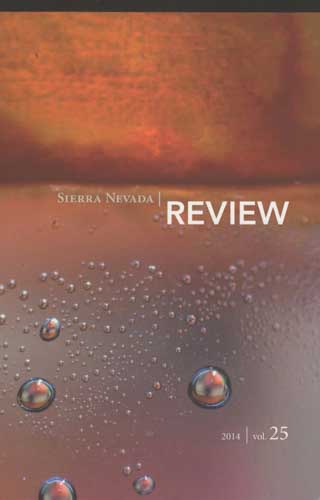Sierra Nevada Review – May 2014
The epigraph at the beginning of this issue of The Sierra Nevada Review comes from Aimé Césaire: “What presides over the poem is not the most lucid intelligence, or the most acute sensibility, but an entire experience: all the women loved, all the desires experienced, all the dreams dreamed, all the images received or grasped, the whole weight of the body, the whole weight of the mind.” This epigraph couldn’t fit more perfectly as each piece within this issue asks the question “What happens when a body (or person) enters a foreign place, what is the experience?” The epigraph at the beginning of this issue of The Sierra Nevada Review comes from Aimé Césaire: “What presides over the poem is not the most lucid intelligence, or the most acute sensibility, but an entire experience: all the women loved, all the desires experienced, all the dreams dreamed, all the images received or grasped, the whole weight of the body, the whole weight of the mind.” This epigraph couldn’t fit more perfectly as each piece within this issue asks the question “What happens when a body (or person) enters a foreign place, what is the experience?”
The journal opens with fiction by Elliot Sanders, “The Coin of Asgard.” This story follows a soldier named Caleb as he serves in the Middle East. Caleb’s sole assignment is to be “a ghost” or escort and follow a man named Akil as he does his daily labor and ensure both Akil’s safety and the safety of others. Caleb is constantly thinking about the strange place he is in and how neither he nor Akil “belong” where they are. Sanders guides readers in a manner that allows them to experience what living in a foreign land was like for Caleb. The story seamlessly switches between what Caleb is doing—“Caleb follows him down the road, which, like everything here, is dust-choked and saturated with sunlight”—and what Caleb is thinking. When put against the dessert backdrop, many of Caleb’s thoughts become almost mirage-like, “At times like these Caleb wonders if the whole base—the roads, the sagging tents, the aircraft parked like hat-stricken bison on the tarmac—will spontaneously begin to melt.” For Caleb experiencing the foreign is almost an out-of-body experience, it jars his mind, and forever changes his worldview.
Lucy Wong continues the theme of inquiry of a foreign place in her nonfiction piece “My Other Uncle.” The story follows Wong and her brother Evan on a trip from the U.S. to China to visit their grandmother and extended family. Wong’s piece answers the question of “what happens when we encounter foreign things?” by stating we try to make sense of them. Throughout the story both siblings encounter that which is foreign. For example, Evan explains his grandmother’s milky eye (likely a result of cataracts) as such: “He stabbed Grandma in the eye with a fork.” As the story progresses we learn of an Uncle that has been institutionalized for over 20 years. Using the institutionalization of her uncle, Wong offers up amazing insight on how things become foreign, what the experience of foreign is from every angle, and spells out what foreign means: alien, alone. Wong recants a conversation she had with someone saying, “After grandma’s death, I heard, from where or who I do not remember, he was told but did not seem to understand. He forgot his own mother.”
Perhaps one of the most impressive poems that everyone should read in this issue is Dalia Ahmed’s “How to Mix Native Blood With Foreign Waters: A Lab,” which deservedly won first place in The Sierra Nevada Review’s High School Writing Contest. This poem not only eloquently plays with form, but it directly addresses the theme that this issue has taken on. This poem is set up as an experiment to test a hypothesis; it begins with a problem statement: “Why do the sands memorize every grain I have wept on?”
Throughout every line of this poem the reader is forced to recognize the difficulty of mixing native with foreign. Under “Materials” reads:
2. Women
· standing barefoot in the kitchen
3. Gold
· dangling off wrists
The materials that are listed are things that are native to the narrator, but when placed against the backdrop of a “foreign” western society it seems there is no room for reconciliation, especially in the form Ahmed has chosen to write in. After laying out the procedures of her test the poem ends with a conclusion: “I am a walking bridge between two east coasts.”
There are so many reasons to pick up a copy of this journal. Not only has it been flawlessly put together, but this issue of The Sierra Nevada Reviewfeatures great work from all the winners of the High School Writing Contest, and it is amazing to see what the younger generation of writers is able to produce. Seriously, get a copy, let the work and the theme inspire you!
[www.sierranevada.edu/academics/humanities-social-sciences/english/the-sierra-nevada-review]





